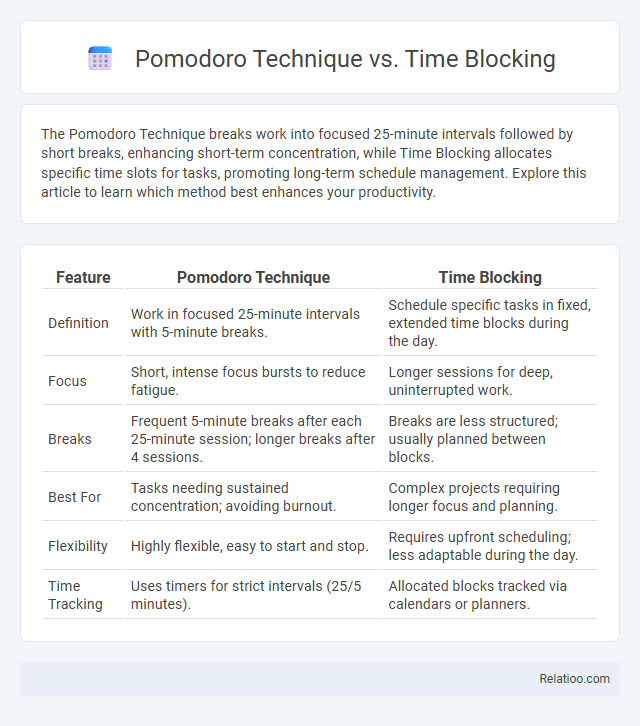The Pomodoro Technique breaks work into focused 25-minute intervals followed by short breaks, enhancing short-term concentration, while Time Blocking allocates specific time slots for tasks, promoting long-term schedule management. Explore this article to learn which method best enhances your productivity.
Table of Comparison
| Feature | Pomodoro Technique | Time Blocking |
|---|---|---|
| Definition | Work in focused 25-minute intervals with 5-minute breaks. | Schedule specific tasks in fixed, extended time blocks during the day. |
| Focus | Short, intense focus bursts to reduce fatigue. | Longer sessions for deep, uninterrupted work. |
| Breaks | Frequent 5-minute breaks after each 25-minute session; longer breaks after 4 sessions. | Breaks are less structured; usually planned between blocks. |
| Best For | Tasks needing sustained concentration; avoiding burnout. | Complex projects requiring longer focus and planning. |
| Flexibility | Highly flexible, easy to start and stop. | Requires upfront scheduling; less adaptable during the day. |
| Time Tracking | Uses timers for strict intervals (25/5 minutes). | Allocated blocks tracked via calendars or planners. |
Introduction to Pomodoro Technique and Time Blocking
The Pomodoro Technique divides your work into focused 25-minute intervals separated by short breaks, maximizing concentration and reducing burnout. Time Blocking schedules specific tasks into set time periods on your calendar, helping to allocate dedicated slots for each activity and improve overall productivity. Comparing these methods highlights how Pomodoro emphasizes short bursts of intense focus, while Time Blocking provides structured, long-term planning for your daily workflow.
Understanding the Basics: What is the Pomodoro Technique?
The Pomodoro Technique is a time management method that breaks work into 25-minute focused intervals called "pomodoros," separated by short breaks. Time Blocking schedules specific chunks of time for tasks on a calendar, while Continuity emphasizes sustained, uninterrupted work to maintain flow. Understanding the Pomodoro Technique helps optimize productivity by balancing intense focus with regular rest, preventing burnout and enhancing concentration.
Exploring Time Blocking: How Does It Work?
Time blocking divides your day into dedicated segments, each reserved for specific tasks or activities, helping to minimize distractions and boost focus. Unlike the Pomodoro Technique, which breaks work into short bursts with frequent breaks, time blocking allocates larger uninterrupted periods to dive deeply into projects. Continuity emphasizes sustained workflow without pauses, but time blocking strategically balances work and rest by scheduling tasks within defined intervals to enhance productivity.
Key Principles: Pomodoro Technique vs Time Blocking
The Pomodoro Technique centers on breaking work into 25-minute focused intervals separated by short breaks to enhance concentration and prevent burnout. Time Blocking involves scheduling specific chunks of your day for different tasks, ensuring dedicated attention and efficient time allocation. Your productivity improves by choosing Pomodoro for managing focus bursts, while Time Blocking organizes broader daily priorities.
Productivity Benefits: Comparing Effectiveness
The Pomodoro Technique enhances productivity by breaking work into focused 25-minute intervals with short breaks, reducing burnout and improving concentration. Time blocking maximizes efficiency by allocating specific time slots for tasks, boosting task prioritization and minimizing distractions. Continuity emphasizes prolonged, uninterrupted work periods, fostering deep focus and sustained momentum, which benefits complex problem-solving and creative projects.
Ideal Use Cases for Each Technique
The Pomodoro Technique excels in boosting focus during short, intense work bursts ideal for tasks requiring high concentration and frequent breaks. Time Blocking is perfect for managing diverse responsibilities across a day, helping you allocate dedicated slots for meetings, deep work, and personal time. Continuity fits best when engaged in creative or long-term projects needing sustained attention without interruption, ensuring steady progress and flow.
Challenges and Limitations of Both Methods
The Pomodoro Technique faces challenges such as frequent interruptions disrupting focus during its strict 25-minute work intervals, while Time Blocking can be limited by unpredictable changes in your schedule that make rigid time slots difficult to maintain. Continuity requires sustained mental effort and can lead to burnout without adequate breaks, making it less effective for tasks needing varied focus levels. Understanding your workflow and task nature helps mitigate these limitations to optimize productivity.
Tools and Apps for Pomodoro and Time Blocking
Pomodoro Technique tools like Focus Booster and TomatoTimer offer customizable intervals and break reminders to boost productivity through timed work sprints. Time Blocking apps such as Google Calendar and Clockwise enable precise scheduling of tasks by allocating dedicated time slots for focused work. Both techniques integrate seamlessly with productivity suites, enhancing task management and minimizing distractions during work sessions.
Tips for Integrating Pomodoro and Time Blocking
Integrate the Pomodoro Technique with Time Blocking by scheduling specific blocks for focused Pomodoro intervals, ensuring concentrated bursts of work followed by short breaks to maintain productivity. Use your calendar to allocate time blocks dedicated to tasks, then break those blocks into 25-minute Pomodoro sessions, helping you manage energy levels and prevent burnout. Your productivity benefits when you combine the structure of Time Blocking with the rhythmic focus of Pomodoro cycles, optimizing concentration and task completion.
Choosing the Best Technique for Your Workflow
The Pomodoro Technique enhances focus by breaking work into 25-minute intervals with short breaks, ideal for tasks requiring high concentration and regular rest. Time Blocking schedules specific tasks or activities into dedicated time slots on a calendar, optimizing productivity through structured planning and minimizing multitasking. Continuity emphasizes sustained, uninterrupted work periods, beneficial for deep creative processes or complex problem-solving, making the choice dependent on whether your workflow demands frequent breaks, structured scheduling, or extended focus.

Infographic: Pomodoro Technique vs Time Blocking
 relatioo.com
relatioo.com